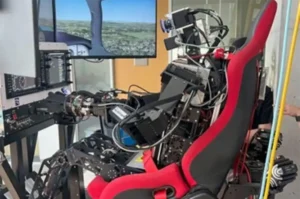You know that niggling worry some folks have about robots swooping in and stealing jobs? It’s a real concern, especially for those with specialized gigs. Even something as intricate as piloting an aircraft isn’t safe from the automation wave. Over in Korea, a sharp group of engineers and researchers are cooking up something special: Pibot. This nifty humanoid robot is mastering the art of flying planes without needing any fancy cockpit alterations. And get this, it’s also gearing up to tackle driving duties, from cars to military rides.
We’re smack dab in the middle of a robot revolution, with AI and robotics taking the spotlight. While some folks sweat bullets over robots stealing their thunder, others see the bright side. These mechanical marvels can take on the heavy lifting and tedious tasks that make us groan. It’s a mixed bag, though. Depending on what you do for a living, it could mean a whole lot of change. Robots can lug around hefty loads, punch the clock for marathon shifts, and they never bug you for a raise. No wonder bosses are smitten. But it does put certain jobs on shaky ground, especially the ones that involve lots of repetitive stuff.
Think your job’s safe just ’cause you’re in medicine or IT? Think again, my friend. Whatever humans can do, you can bet robots are hot on our heels, ready to do it cheaper, faster, and without any coffee breaks. Take KAIST, for example. These brainiacs are leading the charge in building Pibot, a robot that’s not just a jack of all trades but a master of them too. They’ve dubbed it Pibot ’cause it’s all about that pilot life, but truth be told, this bad boy can do a whole lot more with the right training.
So, yeah, Pibot might just be the co-pilot of your dreams, and it’s not stopping at planes. This little buddy is primed to take the wheel of cars, tanks, heck, maybe even ships one day. Picture it like having your own R2-D2 sidekick, except this one doesn’t need you to hold its hand. Sure, some folks might scoff at the idea of a robot looking like us, but hey, it’s got its perks. Pibot can handle all the gadgets and gizmos designed with us in mind.
The folks behind Pibot reckon they’ll have this bot ready to roll by 2026, starting with some action in the military realm. Not surprising, really, considering the project’s got the nod from the big shots over at the Agency for Defense Development in Korea. Keep your eyes peeled, folks. The future’s looking pretty robotic, and Pibot might just be leading the charge.
Pibot is quite the multitasker, able to handle all the controls in a human-designed cockpit with ease. Its arms and fingers are super precise, even when there are jolts and shakes during flight. With the help of external cameras, this robot keeps an eye on all the instruments and important switches on the control panel. Plus, it’s got a fantastic memory, which comes in handy for memorizing those complicated manuals. This memory boost makes it a whiz at flying different kinds of planes with just a bit of training. And get this – Pibot can memorize Jeppesen navigation charts from all around the world, something even human pilots struggle with.
David Shim, an associate professor of electrical engineering at KAIST, sheds some light on the challenges humans face when switching between aircraft. “We humans are pretty good at flying lots of different planes, but our habits can trip us up,” he says. “Switching to a new plane often means getting extra qualifications because our habits stick around. But with Pibot, all it needs is to know what kind of plane it’s flying, and it’s good to go.” Sounds pretty convenient, doesn’t it?
Thanks to some recent advancements in artificial intelligence, especially those fancy large language models, Pibot’s become a real bookworm. It can digest all those flight manuals written by humans and commit them to memory. And guess what? The folks working on Pibot have ChatGPT to thank for speeding up the process. This robot’s memory is top-notch, storing everything from how to fly a plane to what to do in an emergency. Plus, it’s lightning-fast at responding – much quicker than any human out there. And here’s a cool perk: Pibot doesn’t get rattled by emotions, even in tricky situations.
Standing at 160 cm tall (that’s 5 feet 3 inches) and weighing in at 65 kg (that’s about 143 lbs.), Pibot’s ready to step into roles that humans usually take on. Think driving cars, operating tanks, or even taking the helm on a ship out at sea. It’s like having your very own R2-D2 co-pilot, minus the need for a human buddy. Some folks might question whether a robot needs to look like us, but Pibot’s proving that it’s got some serious advantages. With its human-like form, it can interact with all the gadgets and gizmos built with us in mind.
The team’s aiming to have Pibot all set and ready to go by 2026, starting with some action in the military world. It’s no surprise that the Agency for Defense Development (ADD) in Korea is backing this project. They’re the big shots when it comes to researching and developing defense technology, after all. Keep your eyes peeled – the future’s looking pretty exciting, and Pibot might just be leading the charge.










